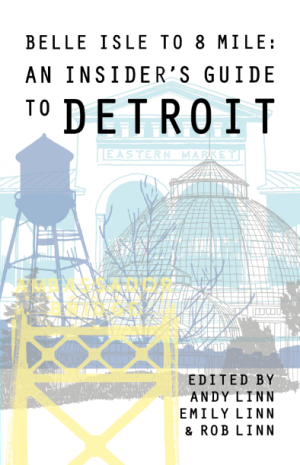
This past December, the city of Detroit got its first comprehensive guidebook since the 1980s. Assembled and edited by a trio of siblings — Emily, Robert and Andrew Linn, all lifelong Detroiters from the city’s Lower East Side neighborhood — the book From Bell Isle to 8 Mile: An Insider’s Guide to Detroit features some 1,000 entries from more than 30 contributing writers.
Below, Robert Linn, an urban planner and data analyst who works for the non-profit Data Driven Detroit, talks about the process of pulling the book together, the response it has gotten from residents and visitors alike, and how the guide will, like the city it covers, expand and grow in the future.
Next City: So this is really the first Detroit guidebook in 30 years?
Robert Linn: We see it as the first comprehensive guidebook in 30 or more years. There have been guides to the city’s architecture, or the city’s restaurants. There’s a great guide for kids’ activities, and there’s a great guide to arts in the city. But this is the first one that includes a range of amenities and destinations.
NC: How did you go about filling in the gaps?
Linn: It was a very long process. I ended up driving about 3,000 miles in the city, and we did a lot of focus groups and surveys. We had a little box for suggestions that we took to public events like parades and festivals to create ideas. In my work as a planner, I’ve become sort of a data specialist, so I created a spreadsheet of several thousands things that someone had recommended to us, be it online or in person or in a focus group. And then we set out on actually visiting all of them to get a sense of what seemed most worthwhile to be in the book.

NC: How did you pick and choose what went into the book?
Linn: That was a challenge for us. There are many possible reasons something could be in the guide. It could be unique in the region, or very interesting, or [have] important architecture. In the book we have listings for everything from monuments to dive bars to soccer teams.
What was most important to us was to show a range of every type of business or cultural attraction. Obviously we can’t include every possible establishment, so we wanted to show a variety, but also what was most exceptional to us.
NC: Your book also offers a look at the history of different neighborhoods within Detroit. Besides the obvious way that this helps — finding what is located where — do you think it’s important for visitors to understand the city on that very local level?
Linn: Perhaps more so than in many cities, Detroit is really a city of neighborhoods, and every neighborhood was developed at a different period, with a different architectural style, for a different group of new residents arriving from different countries. As such, the city still has so many interesting remnants of these very, very different histories.

